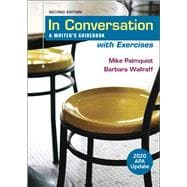PART 1. JOIN THE CONVERSATION
1. Understand Yourself as a Writer
Think of Writing as a Conversation
Understand Your Writing Situation
Manage Your Writing Processes
Work with Others
2. Explore Conversations
2.1 Generate Topics
2.2 Focus on an Issue
2.3 Develop a Writing Question
3. Read Critically and Actively
3.1 Read with an Attitude
3.2 Read with Your Writing Situation in Mind
3.3 Read Actively
PART 2. WORK WITH GENRE AND DESIGN
4. Choose a Genre
4.1 Write a Reflective Essay
4.2 Write an Informative Article
4.3 Write an Annotated Bibliography
4.4 Write a Rhetorical Analysis
4.5 Write a Multimedia Presentation
4.6 Write a Review
4.7 Write a Proposal
4.8 Write an Argument
5. Design Your Document
5.1 Consider Design Principles
5.2 Consider Your Writing Situation
5.3 Use Design Elements Effectively
Genre Design Gallery
PART 3. CONDUCT RESEARCH
6. Collect Information
6.1 Search for Information with Digital Resources
6.2 Search for Information with Print Resources
6.3. Collect Information with Field Research
7. Assess Your Sources
7.1 Assess the Information in Your Sources
*7.2 Pop the Information Bubble
7.3 Apply Evaluative Criteria
8. Manage Your Sources
8.1 Save and Organize Print Information
8.2 Save and Organize Digital Information
8.3 Compile Bibliographies
9. Use Sources Effectively
9.1 Identify Your Sources
9.2 Quote Strategically
9.3 Paraphrase
9.4 Summarize
9.5 Present Numerical Information
9.6 Use Media Sources
10. Understand and Avoid Plagiarism
10.1 Understand Plagiarism
10.2 Understand How to Avoid Plagiarism
10.3 Understand How to Address Accusations of Plagiarism
PART 4. DRAFT YOUR DOCUMENT
11. Define Your Thesis Statement
11.1 Take a Position
11.2 Draft Your Thesis Statement
12. Support Your Main Point
12.1 Choose Reasons
12.2 Gather Evidence
12.3 Reflect on Evidence
*12.4 Analyze Evidence
13. Organize Your Ideas
13.1 Choose a Pattern
13.2 Create Maps and Outlines
14. Write Your First Draft
14.1 Use Your Outline
14.2 Focus Your Paragraphs
14.3 Organize Your Paragraphs
14.4 Create Transitions
14.5 Give Readers a Map
15. Use Sources to Accomplish Your Purpose
15.1 Introduce an Idea
15.2 Contrast Arguments
15.3 Provide Evidence
15.4 Align Your Argument with an Authority
15.5 Define, Illustrate, or Clarify
15.6 Set a Mood
15.7 Provide an Example
15.8 Amplify or Qualify
16. Write Effective Introductions
16.1 Frame the Issue
16.2 Choose an Introductory Strategy
17. Write Effective Conclusions
17.1 Reinforce Your Main Point
17.2 Select a Concluding Strategy
PART 5. REVISE AND EDIT
18. Revise Your Document
18.1 Focus on the Big Picture
18.2 Revise Strategically
19. Edit Your Document
19.1 Edit for Your Readers
19.2 Edit Strategically
*20. Understand the Parts of a Sentence
*20.1 Identify Subjects
*20.2 Identify Verbs
*20.3 Recognize Phrases and Clauses
21. Choose the Right Sentence Structure
21.1 Put Main Ideas in Main Clauses
21.2 Give Multiple Ideas Equal Weight
21.3 Emphasize a Main Idea over a Lesser One
21.4 Combine Coordination and Subordination
22. Write in Complete Sentences
22.1 Turn Fragments into Full Sentences
22.2 Fix Run-On Sentences and Comma Splices
23. Write Clear, Logical Sentences
23.1 Use Parallelism Logically
23.2 Let Readers Know Where Your Sentence Is Going
23.3 Avoid Dangling Words and Phrases
*23.4 Make a Clause Negative
*23.5 Ask a Question
24. Choose Engaging Language
24.1 Choose the Right Words
24.2 Hone Your Phrasing
25. Use Verbs Skillfully
25.1 Match the Number of a Verb and Its Subject
25.2 Use Verb Tense to Indicate Time
25.3 Use Special Moods in Special Cases
26. Use Pronouns to Be Clear
26.1 Match Pronouns with Their Roles
26.2 Make Pronouns Agree with Their Antecedents
26.3 Avoid Vague Pronoun References
27. Use Adjectives, Adverbs, and Articles Expertly
27.1 Use Adjectives to Modify Nouns and Pronouns
27.2 Use Adverbs to Modify Verbs, Adjectives, and Adverbs
27.3 Know When to Use Good, Well, Bad, and Badly
27.4 Compare with Care
*27.5 Use Articles Artfully
28. Use Punctuation to Help Readers
28.1 Use Commas to Keep Your Sentences Organized
28.2 Use Periods, Question Marks, and Exclamation Points to Reinforce Meaning
28.3 Use Quotation Marks When You Borrow Words
28.4 Use Apostrophes in Contractions and Possessive Nouns
28.5 Use Other Punctuation Marks Appropriately
29. Use Sentence Mechanics to Orient Readers
29.1 Use Capital Letters to Mark Beginnings
29.2 Use Italics for Titles of Substantial Works, for Foreign Words, and Sparingly for Emphasis
29.3 Use Abbreviations and Acronyms to Help, Not Frustrate, Readers
*29.4 Spell Well
PART 6. DOCUMENT YOUR SOURCES
30. Use MLA Style
30.1 Cite Sources in the Text of a Document
30.2 Prepare the List of Works Cited
31. Use APA Style
31.1 Cite Sources in the Text of a Document
31.2 Prepare the List of References
32. Use Chicago Style
32.1 Cite Sources in the Text of a Document
32.2 Prepare the Notes and Bibliography
33. Use CSE Style
33.1 Cite Sources in the Text of a Document
33.2 Prepare the List of References
*Exercises
*Answers to Odd-Numbered Exercises
*Sentence Guides for Academic Writers
Glossary of Terms
Frequently Confused, Misused, and Abused Words
Commonly-Used Editing Symbols
(Asterisk = new to the 2e)








